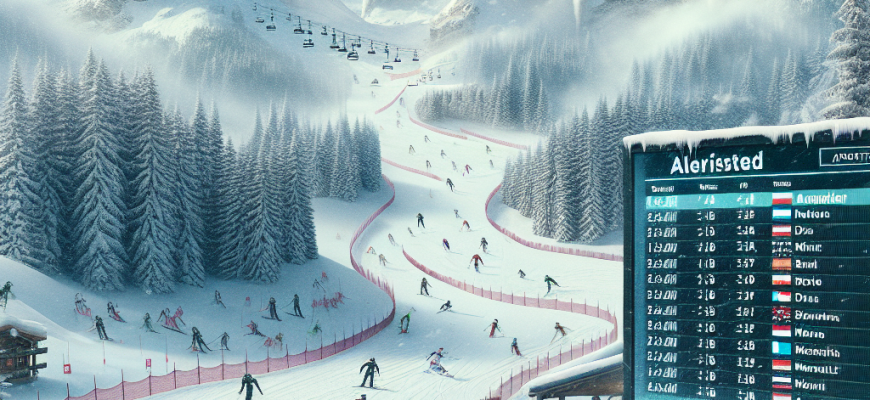- FIS Unleashes New Alpine World Cup Schedule: Navigating the Storm of Weather Woes
- The Weather Conundrum: How Climate Change is Reshaping Alpine Skiing
- Proposed Schedule Changes: The Game Plan
- Delayed Start and a Revamped Calendar
- Geographic Clustering: A Leaner, Greener Race Calendar
- Venue and Event Adjustments: Changing the Game
- North American Races Get a Facelift
- A Tour of New Venues and Exciting Combined Events
- Safety and Environmental Considerations: A Double-Edged Sword
- Mandatory Safety Measures: Keeping Our Athletes Secure
- Environmental Impact Assessment: A Necessary Step
- Recent Challenges and Adaptations: The Ups and Downs
- Seasonal Cancellations: A Hard Pill to Swallow
- Snow Cannons: Our Winter Warriors
- Conclusion: Adapting to the Icy Reality
FIS Unleashes New Alpine World Cup Schedule: Navigating the Storm of Weather Woes
Gather ’round, dear friends, for we stand on the precipice of change in the Alpine World Cup, a grand spectacle of competitive skiing that has captured hearts and raised eyebrows over the years. But alas! The unpredictable whims of Mother Nature—thanks to that pesky little thing called climate change—are throwing a wrench into the precision gears of this winter wonderland. Buckle up, because we’re about to dive deep into the icy waters of the International Ski Federation’s (FIS) recently announced adjustments to the schedule.
The Weather Conundrum: How Climate Change is Reshaping Alpine Skiing
Darlings, it’s no secret that climate change has slipped onto the scene, newly minted as the villain of our tale. The once-reliable winter can no longer be counted on to provide a dependable blanket of snow for our brave skiers. What’s a sport to do when warm weather and barren slopes threaten to disrupt a race calendar that once buzzed like a well-oiled machine? Click here for an in-depth exploration into this environmental saga.
Proposed Schedule Changes: The Game Plan
Delayed Start and a Revamped Calendar
To combat this chaotic weather dance, FIS is striking back with a clever plan: pushing the start of the next season back by a week! Not only that, but they are toying with the idea of stretching the World Cup Finals over two weekends instead of one. Picture this: the first weekend is a thrilling display of technical races—think slalom and giant slalom—while the second weekend cranks up the adrenaline with speed races like downhill and super-G. Oh, how the skiers will relish this new setup!
Geographic Clustering: A Leaner, Greener Race Calendar
In a bold move for environmental justice, the Norwegian Ski Federation has tossed a shiny proposition into the ring: organizing races into geographic clusters. This plan doesn’t just minimize the travel mileage—oh no! It also allows the racers and their trusty crews a moment (or three) to catch their breaths. Imagine a calendar that sets camps in the USA, reducing our carbon footprint and keeping Mother Earth a tad happier!
Venue and Event Adjustments: Changing the Game
North American Races Get a Facelift
Now, let’s spill some tea about our neighbors up north. The latest proposal suggests a thrilling tweak to the women’s World Cup schedule by dropping the classic December speed races in Lake Louise, Alberta, in favor of Mont Tremblant, Quebec. But wait—what’s happening with the men’s speed races in Lake Louise, you ask? Well, my friends, that remains shrouded in mystery!
A Tour of New Venues and Exciting Combined Events
Fast forward to the 2024/2025 season, and you’ll find our beloved tour gracing fresh locales like Levi, Finland, and Gurgl, Austria—this is a first, mind you, for both men and women! Exciting times ahead as the tour pivots back to North America, with stops in the lovely Killington, Vermont, the picturesque Beaver Creek, Colorado, and the already enchanting Tremblant, Canada. Talk about a world tour, full of flares and thrills!
Safety and Environmental Considerations: A Double-Edged Sword
Mandatory Safety Measures: Keeping Our Athletes Secure
With the treacherous changes movin’ and shakin’, it’s paramount that safety takes the front seat. In light of the variable conditions that climate change has dropped in our laps, the FIS is now requiring all our daring downhill and super-G skiers to don safety airbags. Not to mention, the recommendation for cut-resistant underwear is ramping up the assurance levels during those hair-raising speed races!
Environmental Impact Assessment: A Necessary Step
This innovative report from our friends at the Norwegian Ski Federation strongly urges an assessment of how climate change’s relentless march impacts our beloved World Cup. Picture it: strategic scheduling to ensure races unfold under the embrace of natural snow rather than artificial; a rigorous greenhouse gas audit for national teams and organizers—this is the way to chart a course for a sustainable future!
Recent Challenges and Adaptations: The Ups and Downs
Seasonal Cancellations: A Hard Pill to Swallow
The currents of this season have already pulled us into rough waters, marked by cancellations due to snow shortages and unseasonable warmth. For instance, the women’s Audi FIS Ski World Cup giant slalom races scheduled for December 7-8 in Mont-Tremblant were snatched away by the elements, and FIS is scrambling to reschedule these events. It’s a turbulent time, for sure!See more here
Snow Cannons: Our Winter Warriors
Fear not, dear skiers! While the natural snow seems to have taken a hiatus, organizers have valiantly turned to snow cannons to save the day. Yes, my beloved combatants, even with the artificial chill, the struggle is real. The recent event in Gurgl, Austria, showcased the struggle, where relentless snow-making efforts battled against the rain, keeping hope alive. But, oh dear, the bigger picture still looks a bit shaky!
Conclusion: Adapting to the Icy Reality
As we trudge through the snow-laden valleys of uncertainty brought forth by climate change, the FIS appears to be rising to the occasion with tenacity and courage. With a keen focus on safety, a commitment to environmental sustainability, and a desire for seamless logistics, these adaptations pledge to keep our Alpine World Cup vibrant and competitive. So, dear friends, let us cheer for adaptability and resilience as we embrace an ever-changing winter landscape. After all, the show must go on! 🎿❄️









